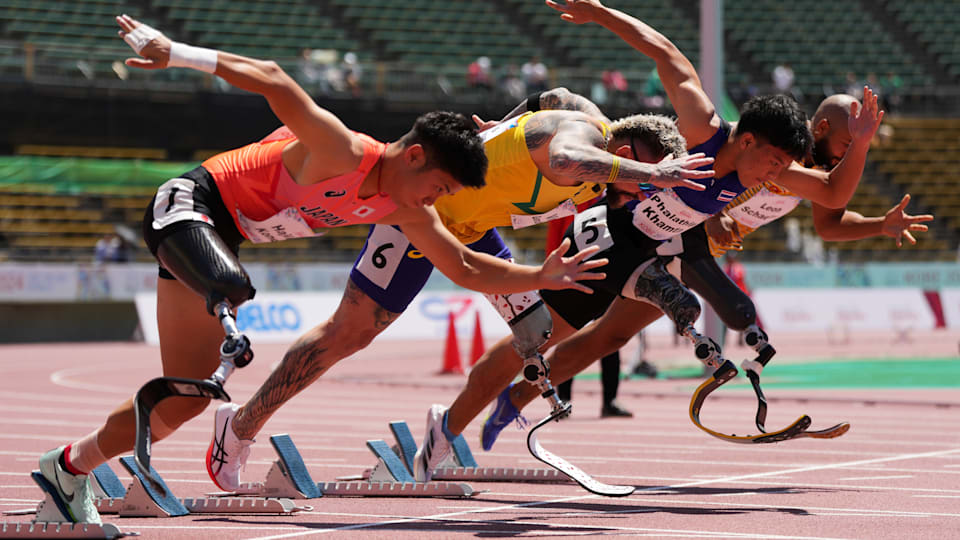Para athletics: the strength of diversity

Athletics is the number one Paralympic sport in terms of the number of events it offers, thanks to a competition that integrates a wide variety of disability categories. In fact, it alone accounts for more than 30% of the Paralympic Games program. It's impossible to miss out!
Let's start with an evocative number: 30. Thirty, the number of gold medals that will be awarded in the legendary 100-meter event alone. An example that perfectly symbolizes the weight of Para athletics, which aims to be inclusive by integrating a wide range of disabilities.
800m T34, long jump T11, shot put F40..., from August 30 to September 7, 160 events will be held on the new Stade de France track. So as not to get lost in the maze of Para athletics classifications, we offer you a complete overview of the different categories.
One letter, two numbers
Paraplegia, tetraplegia and similar conditions, amputation and similar conditions, visual impairment and blindness, cerebral palsy, intellectual disability, short stature - as you can see, the range of disabilities that make it possible to compete in Para athletics is very broad. In fact, almost a quarter of the athletes taking part in the Paralympic Games are registered in Para athletics, a discipline already present in Rome in 1960.
To take full advantage of the competition and the great performances to come, let's take a moment to understand the classification system, which is based on 3 elements. Starting with two capital letters, T and F.
T for "track" for runners and jumpers.
F for "field" for throwing competitions.
Behind the letter are two numbers.
* The first gives an indication of the type of disability:
1 = Visual disability
2 = Intellectual disability
3 = Coordination disability
4 = Short stature or upper limb disability without the use of a prosthesis
5 = Spinal cord injury
6 = Lower limb disability with the use of prosthesis(s)
* The second informs you about the degree of disability. 1 being the highest degree, up to 8, the lowest degree.
After the letter T or F, you'll find these numbers whose meaning is :
-
11 to 13: 11 for total blindness (a guide accompanies the race), 12 (a guide may or may not accompany the athlete if he or she so wishes) and 13 (no guide) for the visually impaired.
-
20: for mentally disabled athletes
-
31 to 38: these categories are linked to cerebral palsy:
wheelchair racing (T33-34)
seated throws (F31-34)
athletes with sufficient function to run and jump (T35-38)
athletes with sufficient function for standing throwing (F35-38) -
40 to 47: categories 40 and 41 are for athletes of short stature.
Athletes in categories 42, 43 and 44 have impaired muscular power above or below the knee (single and/or bilateral).
Athletes in categories 45, 46 or 47 have amputated both arms (45), or one above the elbow (46), or between the elbow and wrist (47). -
51 to 57: wheelchair races (T51-54) and seated throws (F51-57).
-
61 to 64: athletes with lower-limb amputations and prostheses compete here: femoral amputees (61), tibial amputees (62), femoral amputees (63) and tibial amputees (64).
A voice for everyone
To ensure that everyone can defend their chances fairly and with respect, the rules have been adapted. So every para-athlete has the right to compete and experience the thrill of the Paralympics in the best possible conditions! Some can run or throw in wheelchairs, others use special prostheses, while visually impaired athletes are accompanied by guides. On the track, these duos logically take up more space on the 8 lanes. As a result, only 4 pairs compete simultaneously.
Another adaptation was made for the seated throwing events. Because the athlete's seat has to be securely fixed to the ground and the thrower to his or her seat via a system of straps, each athlete makes all his or her throws in succession, rather than alternately as Olympic throwers do.
Worth knowing
- Para athletics is one of only three Paralympic disciplines open to athletes with an intellectual disability. The other two are Para swimming and Para table tennis.
- Club-throwing is a discipline specific to Para athletics, open to athletes who have difficulty holding a shot put, discus or javelin.
- Seated throwing events require special equipment, such as a ground plate, to enable the athlete to be stable and in a secure position.
- Wheelchair athletes are classified in categories 31 to 34 and 51 to 54. Chair weights range from 8 to 10 kilos and lengths from 170 to 185 centimetres. At full effort, athletes can reach speeds up to 36 km/h.
- The world record for the T64 long jump is 8.72m. It was set in June 2023 by German champion Markus Rehm (3 Paralympic gold medals). This performance places him just 23 centimetres short of the world record in the Olympic category (8.95m achieved by Mike Powell in 1991). With such a performance, he would even have been Olympic champion in 2021, since Miltiádis Tedóglou won the long jump competition with a mark of 8.41m.
A track designed for performance and the future
The new athletics track installed at the Stade de France also aims to make history. Manufactured by Mondo, a company with expertise in designing tracks for the world's greatest sporting events, it hopes to follow in the footsteps of its predecessors, on which 300 world records have already been broken since 1972 (the date of the first record achieved on a Mondo track).
What's more, the track has been designed to meet both sporting and environmental expectations. Mondo favors the use of non-fossil products (50% renewable and non-fossil materials for the Paris 2024 track, compared with 35% for the London 2012 track), as well as the reuse of its infrastructure at the end of its life.
Find out all about the new Stade de France athletics track